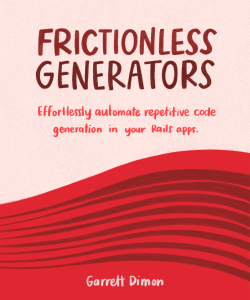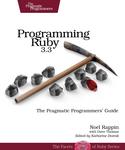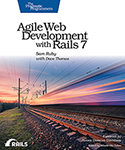About This Title
Pages: 166
Published: April 2024
ISBN: pending
In Print
Frictionless Generators
by Garrett Dimon
Did you know that you can effortlessly create well-tested, reliable, and easy-to-use generators that save time? And when you create a custom generator, it doesn’t just save time for you but for your entire team. Over. And over. And over again. Every single Rails project already provides all of the tools to build custom generators. With a little guidance, you can use them just as effortlessly as every other part of Rails.
This work was written and produced entirely by the author. We are proud to be distributing it.
eBook Formats:
PDF for desktop/tablets
epub for Apple Books, e-readers
Get all eBook formats here for $29.00 (USD)
Frictionless Generators takes a holistic approach to help you see how to efficiently create and test custom Rails Generators so you and your team can save time. Think of it as a guide for saving time that just happens to use custom Rails Generators as the methodology.
It provides over 150 pages of pragmatic tips, tactics, and code samples to help you avoid speed bumps and get right into creating your own generators. It covers all of the key APIs and tools for creating generators while also avoiding getting stuck in the weeds or creating generators nobody will ever use.
But it’s not just about learning how to create them. It’s about learning when to not create one. It’s about recognizing when and how to customize an existing generator so you don’t reinvent the wheel.
Set aside any preconceived notions you may have about creating custom generators in Rails, and you’ll add one more powerful tool to that tool belt of yours. And you’ll waste less time on the tedious stuff so you can spend it on the high-value work you do.
What You Need
You’ll need a working development environment to run Ruby on Rails. The book was written with Ruby 3.2 and Rails 7.1, however you should be able to follow along and use any supported version of Ruby or Rails.Resources
Releases:
Contents & Extracts
- A (Brief)
Introduction

- 1. Save Time and Reduce
Tedium

- 2. Generate the Big Picture
- 2.1 The Generator & Templates Folder
- 2.2 The Tests
- 2.3 The Command Line & Help
- 2.4 Actions
- 2.5 Templates, Sources, and Destinations
- 2.6 Arguments, Options, and Interactivity
- 2.7 Parent Class Options
- 2.8 Naming Considerations
- 2.9 Summary & Review: The Big Picture
- 3. Arguments & Options
- 3.1 What’s the difference?
- 3.2 Arguments
- 3.3 Options
- 3.4 Judicious Arguments and Options
- 3.5 Our Generator: Arguments & Options
- 3.6 Summary & Review: Arguments & Options
- 4. Usability & Interactivity
- 4.1 Providing Helpful Documentation
- 4.2 Argument Banner Enhancements
- 4.3 Our Generator: Better Banners & Docs
- 4.4 Usage File & Descriptions
- 4.5 Our Generator: Writing the Usage
- 4.6 Communicating Status
- 4.7 Argument & Option Error Handling
- 4.8 Our Generator: Custom Error Handling
- 4.9 Interactive Prompts
- 4.10 Our Generator: Graceful Custom Error Handling
- 4.11 Respecting Quiet Time
- 4.12 Summary & Review: Usability & Interactivity
- 5. Leveraging Templates & Testing
excerpt

- 5.1 Templates
- 5.2 Testing Generators
- 5.3 Take Care with Locations
- 5.4 Our Generator: Adding Templates & Tests
- 5.5 Summary & Review: Templates & Testing
- 6. Creating & Modifying Files
- 6.1 Creating without Templates
- 6.2 Modifying Existing Files
- 6.3 Deleting Files & Directories
- 6.4 Summary & Review: Creating & Modifying
- 7. Utility & System Actions
- 7.1 The Basics
- 7.2 Version Control with Git
- 7.3 Doing more with Ruby
- 7.4 Additional Utilities
- 7.5 Finding Files in Source Paths
- 7.6 Summary & Review: Utilities
- 8. Extending & Customizing
- 8.1 Leverage Rails & Introspection
- 8.2 Re-configure at the System Level
- 8.3 Overriding Individual Generators
- 8.4 Calling a Generator from a Generator
- 8.5 Hooking into Generators
- 8.6 Inheritance
- 8.7 Taking it Further
- 8.8 Summary & Review: Extending & Customizing
- Afterword
- Acknowledgments
- Appendix
Author
Garrett Dimon has been designing and building on the web since 1998 and has been using Ruby and Rails since 2008 when he built his first SaaS application as a sole founder. After eight years of running it, he sold it to focus on recovering from health issues. Since then, he’s played key roles in the design and development of a wide variety of Rails applications and Ruby gems.eBook Formats:
PDF for desktop/tablets
epub for Apple Books, e-readers
Get all eBook formats here for $29.00 (USD)
Related Titles:
About This Title
Pages: 166
Published: April 2024
ISBN: pending
Edition: 1
In Print




